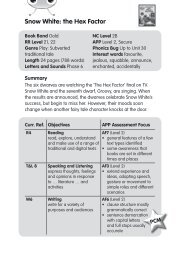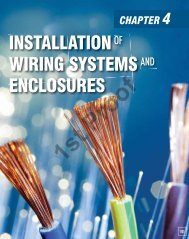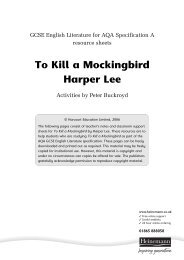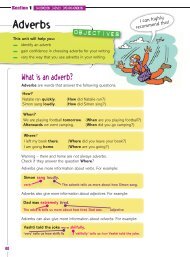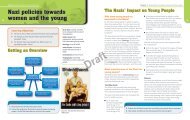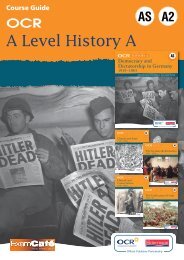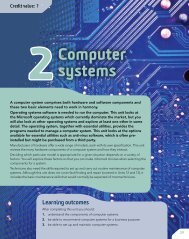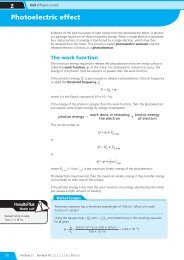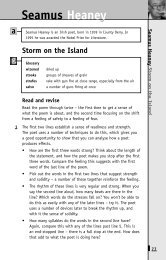Chapter 6 - Level 2 NVQ and Technical ... - Pearson Schools
Chapter 6 - Level 2 NVQ and Technical ... - Pearson Schools
Chapter 6 - Level 2 NVQ and Technical ... - Pearson Schools
Create successful ePaper yourself
Turn your PDF publications into a flip-book with our unique Google optimized e-Paper software.
<strong>NVQ</strong>2 Electrical Installations<br />
ring<br />
circuit<br />
ring<br />
circuit<br />
134<br />
ring<br />
circuit<br />
ring<br />
circuit<br />
single-socket outlet<br />
double-socket outlet<br />
Figure 6.18 Non-fused spurs<br />
fused connection unit with switch<br />
appliance<br />
fused connection unit (not exceeding 13 A)<br />
Remember<br />
The cable sizes shown<br />
are nominal, <strong>and</strong> if<br />
derating factors apply<br />
e.g. grouping or ambient<br />
temperature, these<br />
sizes may need to be<br />
increased. In practice this<br />
would mean that a 30 A<br />
or 32 A circuit breaker or<br />
fuse would be used as an<br />
overcurrent protection<br />
device <strong>and</strong> the circuit<br />
cable would be selected<br />
accordingly as required<br />
by Regulation 433-02-04<br />
Figure 6.19 Fused spurs<br />
appliance<br />
Radial circuits<br />
Non-fused spurs<br />
Spurs may be installed on a ring circuit. These may be fused, but it is<br />
more common to install non-fused spurs connected to a circuit at<br />
the terminals of socket outlets, at junction boxes, or at the origin of<br />
the circuit in the distribution board. A non-fused spur may supply<br />
only one single or one twin-socket outlet or one item of permanently<br />
connected equipment. The total number of non-fused spurs should<br />
not exceed the total number of socket outlets <strong>and</strong> items of fixed<br />
equipment connected directly to the ring circuit. The size of conductor<br />
for a non-fused spur must be the same as the size of conductor used<br />
on the ring circuit.<br />
Fused spurs<br />
A fused spur is connected to a circuit through a fused connection<br />
unit. The fuse incorporated should be related to the current carrying<br />
capacity of the cable used for the spur but should not exceed 13 A.<br />
When sockets are wired from a fused spur the minimum size of the<br />
conductor is 1.5mm2 for rubber- or PVC-insulated cables with copper<br />
conductors <strong>and</strong> 1mm2 ��������<br />
������ ���� ������ � �������<br />
�<br />
for mineral-insulated cables with copper<br />
conductors. The total number of fused spurs is unlimited.<br />
In a radial circuit the conductors do not form a loop but finish at the last outlet. As<br />
with the ring circuit, the number of outlets in any circuit is unlimited in a floor area<br />
up to the maximum allowed. In each case this will be determined by the estimated<br />
load <strong>and</strong> shock protection constraints.<br />
A2 Radial circuit<br />
The current rating of the cables is determined by the rating of the overcurrent<br />
protection device, i.e. 30 A or 32 A cartridge fuse or MCB. This means that copperconductor<br />
PVC cables of not less than 4mm 2 , or copper-conductor mineral-insulated<br />
cables of not less than 2.5mm 2 , may be used, <strong>and</strong> the floor area served may not<br />
exceed 75m 2 . See Figure 6.20 <strong>and</strong> Table 6.04.<br />
floor area<br />
maximum 75 m 2<br />
Figure 6.20 A2 radial circuit<br />
4 mm2 30 A/32 A



